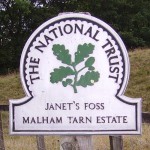How Do You Solve the National Trust’s UGC Dilemna?
In fact, the challenge comes up front in the creation of the “hub” site and then the core template (or perhaps templates as one size may not fit all) for its property websites. Once these first few are out of the way, and we’re promised 6 property websites by the end of September and the new main site by the end of the year, the others should be, relatively, straightforward.
Anybody who has used nationaltrust.org.uk will not find it hard to understand why it needs an overhaul – a pleasing facade soon degenerates into navigation lists so long they disappear beyond the reaches of the scroll bar and there’s a distinctly disappointing lack of information once you do reach your destination.
I see 2 challenges:
1. What Information to Release When – precisely what information do I need to make an informed decision about whether to visit somewhere, what information do I need when I get there and what information should be offered for a premium. In effect, what do I put on the Trust website, what on the property website and what in a paid for guide. It’s the same conundrum that newspaper publishers are wrestling with in terms of what should be free and what will people pay for .

National Trust To Launch 300+ Property Websites
2. Encouraging involvement so the user-generated side of the property sites actually has user generated content on there – I think this is a laudable aim. It chimes directly with the Trust’s desire to build an ongoing dialogue with its members and visitors but it’s in danger of falling flat on its face unless some real effort is put into it by supporting this intiative with other marketing disciplines i.e. some good old integrated marketing. For example:
- Internal marketing to volunteers – who’ll not only be an important source of UGC themselves, and will be key in ‘getting the ball rolling’, but will also play in role in encouraging visitors to get involved (‘that looks like a wonderful photo – why don’t you upload it onto our website’).
- Internal marketing to regional teams – who are no doubt going to have to moderate the content to a degree.
- Onsite marketing – why not leave your comments/upload your photographs while you’re there? A few laptops/PCs accessible in the tea rooms would reach a receptive audience.
- Email or Text marketing – to members the day after their trip to remind them to rate the property, leave comments and upload their pics.
- Integrating Content from Offline Sources – such as existing questionnaires, as long as permissions have been gathered from the recipients of course.

How much UGC Can a Tithe Barn Generate?
Even with this level of support, I still worry about the odd NT preserved tithe barn in the heart of Worcestershire and exactly what potential it has to engender UGC. The template(s) are going to have to deliver quality customer experiences even when UGC is scarce.
And finally, you could argue even 300+ National Trust sites doesn’t go far enough – what about the causes outlined in the Trust’s new 2010 & Beyond strategy document. Can one site support their commitment to the nation’s heritage and open spaces as well as their commitment to the organic food and global warming debates? But that’s a subject for another time.
